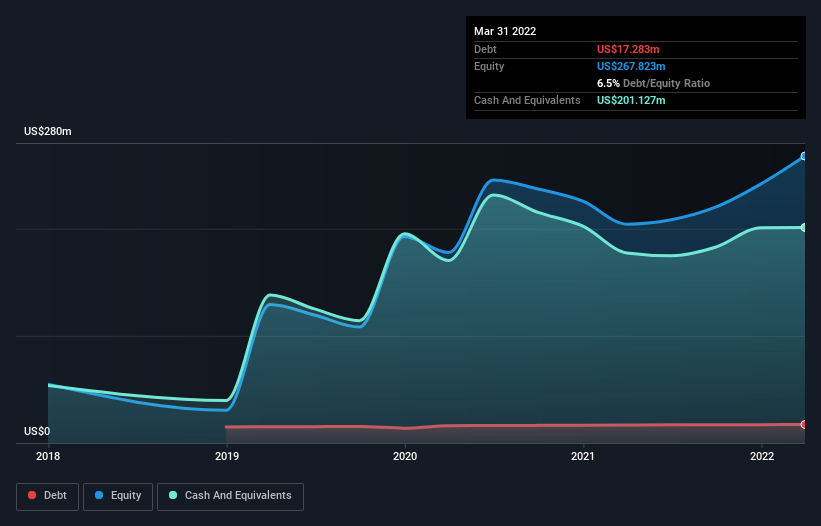Is ShockWave Medical (NASDAQ:SWAV) A Risky Investment?
David Iben put it well when he said, 'Volatility is not a risk we care about. What we care about is avoiding the permanent loss of capital.' So it might be obvious that you need to consider debt, when you think about how risky any given stock is, because too much debt can sink a company. As with many other companies ShockWave Medical, Inc. (NASDAQ:SWAV) makes use of debt. But the more important question is: how much risk is that debt creating?
Why Does Debt Bring Risk?
Debt is a tool to help businesses grow, but if a business is incapable of paying off its lenders, then it exists at their mercy. In the worst case scenario, a company can go bankrupt if it cannot pay its creditors. However, a more frequent (but still costly) occurrence is where a company must issue shares at bargain-basement prices, permanently diluting shareholders, just to shore up its balance sheet. Of course, the upside of debt is that it often represents cheap capital, especially when it replaces dilution in a company with the ability to reinvest at high rates of return. The first thing to do when considering how much debt a business uses is to look at its cash and debt together.
View our latest analysis for ShockWave Medical
How Much Debt Does ShockWave Medical Carry?
The chart below, which you can click on for greater detail, shows that ShockWave Medical had US$17.3m in debt in March 2022; about the same as the year before. But it also has US$201.1m in cash to offset that, meaning it has US$183.8m net cash.
How Strong Is ShockWave Medical's Balance Sheet?
Zooming in on the latest balance sheet data, we can see that ShockWave Medical had liabilities of US$51.0m due within 12 months and liabilities of US$53.7m due beyond that. On the other hand, it had cash of US$201.1m and US$47.8m worth of receivables due within a year. So it can boast US$144.3m more liquid assets than total liabilities.
This surplus suggests that ShockWave Medical has a conservative balance sheet, and could probably eliminate its debt without much difficulty. Succinctly put, ShockWave Medical boasts net cash, so it's fair to say it does not have a heavy debt load!
It was also good to see that despite losing money on the EBIT line last year, ShockWave Medical turned things around in the last 12 months, delivering and EBIT of US$32m. There's no doubt that we learn most about debt from the balance sheet. But ultimately the future profitability of the business will decide if ShockWave Medical can strengthen its balance sheet over time. So if you want to see what the professionals think, you might find this free report on analyst profit forecasts to be interesting.
Finally, a business needs free cash flow to pay off debt; accounting profits just don't cut it. ShockWave Medical may have net cash on the balance sheet, but it is still interesting to look at how well the business converts its earnings before interest and tax (EBIT) to free cash flow, because that will influence both its need for, and its capacity to manage debt. Over the most recent year, ShockWave Medical recorded free cash flow worth 71% of its EBIT, which is around normal, given free cash flow excludes interest and tax. This free cash flow puts the company in a good position to pay down debt, when appropriate.
Summing up
While we empathize with investors who find debt concerning, you should keep in mind that ShockWave Medical has net cash of US$183.8m, as well as more liquid assets than liabilities. And it impressed us with free cash flow of US$23m, being 71% of its EBIT. So we don't think ShockWave Medical's use of debt is risky. The balance sheet is clearly the area to focus on when you are analysing debt. However, not all investment risk resides within the balance sheet - far from it. For example - ShockWave Medical has 3 warning signs we think you should be aware of.
When all is said and done, sometimes its easier to focus on companies that don't even need debt. Readers can access a list of growth stocks with zero net debt 100% free, right now.
Have feedback on this article? Concerned about the content? Get in touch with us directly. Alternatively, email editorial-team (at) simplywallst.com.
This article by Simply Wall St is general in nature. We provide commentary based on historical data and analyst forecasts only using an unbiased methodology and our articles are not intended to be financial advice. It does not constitute a recommendation to buy or sell any stock, and does not take account of your objectives, or your financial situation. We aim to bring you long-term focused analysis driven by fundamental data. Note that our analysis may not factor in the latest price-sensitive company announcements or qualitative material. Simply Wall St has no position in any stocks mentioned.


